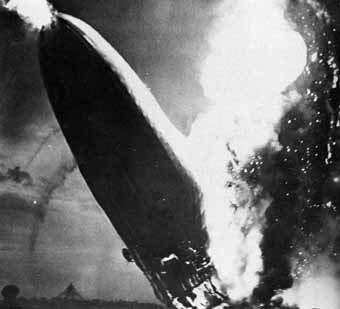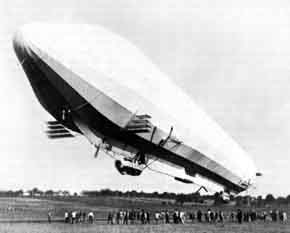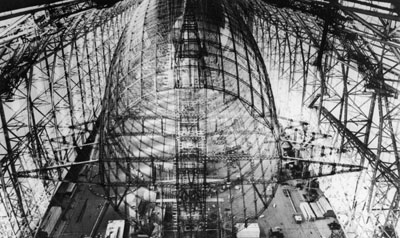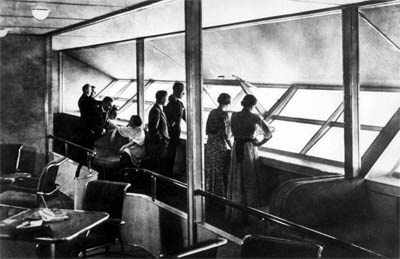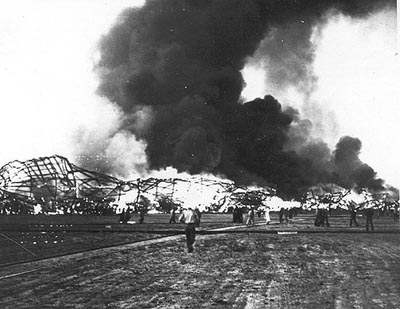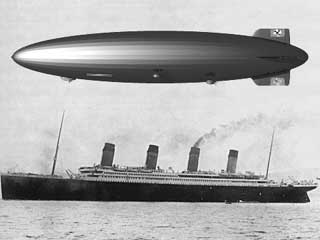The Mystery of the Hindenburg Disaster It was the largest airship ever built; over eight-hundred feet long from its nose to its massive tail fins. It was the height of luxury travel and in the course of two seasons carried over 2,656 people across the Atlantic between Germany to New York and Rio de Janeiro. It was called the Hindenburg and the space of 37 seconds this mighty zeppelin was destroyed in a fire that killed a third of its crew and passengers and left spectators crying in horror. What caused this catastrophe? Was it negligence, sabotage, or as Hitler called it, "An act of God"? The Dirigible The first successful dirigible (a balloon that has engines to control its horizontal movement) was built in France in 1852. Although other countries built these types of airships, the Germans quickly became the most advanced builders of this form of lighter-than-air technology. Count Ferdinand von Zeppelin, a German businessman, built a fleet of experimental dirigibles. The type of airships Zeppelin built were spindle-shaped with a rigid internal steel structure (unlike the flexible bodied blimps common today). Inside the craft were large bags filled with gas that gave the ship its lift, as well as catwalks to allow the crew to move back and forth inside the hull to service the airship. Beneath the craft was a gondola which carried the crew and passengers. By 1911 Zeppelin's airship LZ-10 (also known as the Schwaben) was in passenger service and would go onto make 218 flights carrying 1,553 passengers. Zeppelin became so well-known for this type of dirigible that his name soon became synonymous with that type of airship. Starting in 1914, the beginning of WWI, the Count's zeppelins were used to drop bombs on cities in a number of European countries. They made over fifty raids on London alone, dropping nearly 200 tons of explosives. As the war progressed, however, most of the German's zeppelin fleet was destroyed by British guns or aircraft. The gas that gave them their lift, hydrogen, was very flammable, and even a small bomb hitting a zeppelin could reduce it to ashes in just a few minutes.
After the war Germany again began building large airships. As part of war reparations the Germans built the ZR-3 Los Angeles for the U.S. Navy. In 1928 the Zeppelin Company built what was the most successful passenger dirigible of all time, the Graf Zeppelin. The Graf Zeppelin was a hundred feet longer than any other airship ever built and stretched 776 feet from nose to tail fins. It was designed as a passenger liner to compete with the ocean liners crossing the Atlantic. With a maximum speed of 80 miles per hour, it cut the time it took to make the trip by more than two-thirds. The passenger cabin was outfitted with drapes and thick carpeting. Dinner was made by professional chefs and was served using silverware, crystal and fine china. Time magazine declared, "Certainly for trans-oceanic trips, the airship is the thing." Constructing The Hindenburg The Graf Zeppelin was so successful that the Zeppelin Company planned a new airship. One that would be bigger, faster and carry more passengers with more luxurious amenities. It would be named after a national hero who had been elected Germany's president in 1925. It would be called the Hindenburg. The Hindenburg was not only longer than the Graf Zeppelin, it was an extra 35 feet wide. This meant it had nearly twice the volume for lifting gas (7,062,000 cubic feet) than the Graf Zeppelin. There was a reason for this. The Hindenburg's designers had decided to fill the new dirigible with helium gas, not hydrogen. Helium, unlike hydrogen, does not burn, making it safer. However, it doesn't produce as much lift as hydrogen, so the extra volume the Hindenburg had for gas was an important feature. The Hindenburg never got its helium, though. At that time helium was difficult to produce and the United States had a monopoly on the manufacture of it. When the Americans saw that Hitler was in power in Germany, they feared he would use the gas for military purposes and therefore would not sell the Germans the helium necessary to fill the Hindenburg. The Zeppelin Company was forced to redesign the ship for hydrogen and make changes to minimize the possibility of fire.
Though it might seem strange to us today, back then the airship seemed to be the wave of the future in travel. At that time crossing the Atlantic in an airplane was risky business. Planes could travel only short distances carrying a minimum of weight and required constant refueling. To many the zeppelins was the natural successor to the ocean liner. The Zeppelin Company planned that the Hindenburg would be the first of a fleet of airships plying the skies of the world. Even today the Hindenburg remains the largest aircraft ever flown. Some of the smaller, modern advertising blimps have a total length only slightly larger than the girth of the Hindenburg. If the Hindenburg stood on end it would dwarf the Washington Monument. It could lift 112 tons beyond its own weight, an incredible amount for that time. Passengers enjoyed staterooms with private showers. The dining room served the finest food on blue and gold porcelain place settings. The ship provided the passengers a spectacular view along its windowed 200-foot-long promenade deck. One restriction the ship had though was smoking. Because of the hydrogen, smoking was permitted only in a special fireproof room. Final Flight A one-way trip across the Atlantic cost $400 and took only two days. Flights began in 1936 with the airship making a total of six trips to Rio de Janeiro and ten trips to New York City carrying a total of 2,656 passengers. In 1937 it made a trip to Rio then returned to Germany. On May 3rd, 1937, the Zeppelin departed Frankfurt for North America carrying 97 people. It would be the first trip to New York City that season. The trip went smoothly and by 11:40 A.M. on May 6th the airship was passing over Boston. Landing at the Naval Air Station in Lakehurst was delayed due to bad weather, so the ship's captain, Commander Max Pruss, decided to linger over New York City, giving his passengers spectacular views of the Empire State Building, the Bronx, Harlem, Central Park, the Battery, Times Square, the Statue of Liberty and Ebbets Field (where a game was being played between the Dodgers and the Pittsburgh Pirates). At 4 P.M. the Hindenburg arrived over Lakehurst, but the weather was still worrisome. Commander Pruss decided to take the ship southeast until he hit shore, then north to Asbury Park, then finally inland back to Lakehurst. At 6:12 Charles E. Rosendahl, Commanding Officer of the Lakehurst N.A.S., sent a message to the Hindenburg: "Conditions now considered suitable for landing." Eleven minutes later a stronger message followed: "Recommend landing now."
The Landing It was almost a half hour later, at 7:00 P.M., that the Hindenburg started its landing. It circled the base, dropping its altitude from 600 to 300 feet and aligned itself so it was headed into the wind. As it approached the mooring mast, Captain Pruss realized he was going a little too fast. Also the wind was changing direction. Given that he was already late, he decided not to do a complete go around, but slow the ship and change his approach by making a sharp "S" turn, first left, then right. To further complicate things for the captain, the airship was losing trim. The tail section was dropping. This was not particularly odd as it had been raining the water tended to cling more to the rear of the ship than the front, making it heavier. Puss ordered some ballast dropped and six crewmen were sent scurrying to the bow of the dirigible to balance it. The turn worked and the zeppelin's nose finally faced the mooring mast where it would be secured. As the Hindenburg got within 700 feet of the mast, the engines were reversed, bringing the ship to a stop. Ropes were dropped to allow the ground crew to tow the ship into position. At this point the Zeppelin was hanging about 275 off the ground. It was 7:25 P.M.. On the ground a radio reporter named Herbert Morrison was covering the airship's arrival and his comments were recorded for prosperity: ...It's practically standing still now. They've dropped ropes out of the nose of the ship, and it's been taken a hold of down on the field by a number of men. It's starting to rain again; the rain had slacked up a little bit. The back motors of the ship are just holding it, just enough to keep it from --" "It burst into flames! ... It's fire and it's crashing! It's crashing terrible! Oh, my! Get out of the way, please! It's burning, bursting into flames and is falling on the mooring mast, and all the folks agree that this is terrible. This is the worst of the worst catastrophes in the world! ...There's smoke, and there's flames, now, and the frame is crashing to the ground, not quite to the mooring mast...Oh, the humanity, and all the passengers screaming around here! The flames were first visible towards the tail of the ship, then within seconds the hydrogen in the gas bags caught on and the whole aft of the craft was engulfed in a mass of flame and smoke that towered hundreds of feet into the sky. As the hydrogen in the rear of the ship burned, the rear of the Hindenburg lost its lift and fell to the ground and its nose pointed upwards at a forty-five degree angle. Then as the flames raced through to the bow, it also fell. In just 37 seconds since the first flames were spotted the ship lay on the ground, the skeleton of its framework the only thing visible through the fire. Passengers jumped from windows and ran for safety. One cabin boy had his life saved when a water tank burst above his head. Of the 97 people on board, miraculously 62 managed to escape with their lives, including the ship's captain. An investigation into the cause of the disaster was made both by the United States and the German governments. They concluded a hydrogen leak was ignited by a spark of static electricity. Both governments wanted to close the book on the disaster. The Americans were anxious to avoid an international incident and the Germans were embarrassed that the cause might have been a design flaw in the ship or the result of foul play. The Gas Leak Theory Some theories suggest that Commander Pruss's final turns to land were too sharp and they caused a support wire to snap inside the ship tearing open one of the hydrogen gas cells. The leaking gas then might have been set off by a rare, natural electrical phenomenon known was St. Elmo's fire. St. Elmo's fire is usually seen as a static electric charge around high objects (like church steeples) during stormy weather. Given the weather on that day, it is very likely that the ship was carrying a static electric charge. Just before the fire broke out, witnesses saw a fluttering movement of the ship's skin near the rear of the vessel. Some people argue this was caused by escaping gas. Other witnesses noticed a blue glow around the rear of the vessel that might have been St. Elmo's fire. If the gas escaped out a ventilation shaft and met the static electric discharge, it might well have triggered the fire. The Lightning Theory Instead of st. Elmo's Fire, lightning is sometimes blamed as the cause of the fire. However, the Hindenburg had been struck several times before by lightning with no damage. If lightning was the cause of the disaster, it seems it must have been coupled with a gas leak, as with the above theory. However, no witnesses saw lightning strike the ship and there were no known thunderstorms in the immediate area. Diesel Theory This theory suggests that the diesel fuel used to power the engines may have started the fire. A leak from a malfunctioning fuel pump might have ignited if the fuel reached a hot surface like the engine block. The pods where the engines were housed, however, were not by all accounts the location where the fire started. Initially engineers suspected that sparks from a backfiring engine might have ignited hydrogen from a leak, but tests showed that these type of sparks were not actually hot enough to have set the gas on fire. The Flammable Skin Theory A theory suggested by Addison Bain, former manager of NASA's hydrogen program, was that the initial fire was not caused by burning hydrogen. Hydrogen burns without much of a visible flame, but witnesses described the fire as extremely colorful. Bain thinks the doping solution used to stretch and waterproof the hull was responsible. The compound, a layer of iron oxide covered with coats of cellulose butyrate acetate mixed with powdered aluminum, is very similar to a mixture used to power solid fuel rockets. "The Hindenburg was literally painted with rocket fuel," says Bain. Bain suspects that the Germans figured out the real cause, though they didn't want to admit they'd made such a dangerous mistake. The doping solution used on the Graf Zeppelin II, completed after the Hindenburg disaster, was changed to include a fireproofing agent and the aluminum was replaced with bronze which is less combustible. Bain thinks the fire was started by a build-up of static charge from the storm on the craft's surface and frame. When the mooring ropes (wet from the storm) were dropped to the ground, the frame discharged, creating an electrical differential between the frame and covering which started the fire.
Tests have been run with remains of the covering, however, that show that although it is flammable , it doesn't burn with the speed needed to explain the rapid expansion of the fire through the whole ship. If the fire did start with the skin, it seems it must have ignited the hydrogen cells almost immediately. The Sabotage Theory Some of the crew that survived, including Commander Pruss, suspected the fire was sabotage. The Hindenburg was more than just a German airship. It was a symbol of German power and technical prowess. Hitler's government, which had helped pay for the Hindenburg's construction, had employed it for such jobs as making propaganda appearances over the 1936 Olympic Games in Berlin. Each of the huge tail fins of the Hindenburg wore the swastika emblem, the symbol of Hitler's Nazi party. Officials had been concerned even before the ship reached New York that someone opposing Hitler might make a terrorist attack upon the craft. If a saboteur was at work, it must have been one of the crew or passengers. If so, that person may have placed a time bomb along one of the ship's internal catwalks. Most likely it detonated prematurely, or the saboteur did not count on the craft being so late at arriving and could not return to the bomb to reset the timing mechanism. Either way the saboteur may have died in the resulting explosion. A bomb placed near the rear of the craft might have explained the initial flare forward of the tail fin as reported by witnesses as flames from the explosion shot up the gas ventilation shaft to burst out the top of its hood. The initial explosion would have ruptured the hydrogen gas cells, causing a more powerful second explosion that destroyed the craft. Suspicion for the sabotage initially fell upon Joseph Spah, a passenger who survived. On several occasions Spah, a New Jersey resident, had gone unescorted into the cargo area of the ship to visit his dog that he was bringing home to his children. This might have given him the opportunity to place a bomb. Later, others suspected that Erich Spehl, an introverted crewman who perished in the fire, might have been the saboteur. Spehl was thought to have had anti-Nazi leanings.
There is no proof against either of these gentlemen and in a search of the wreckage no parts of a bomb were found. Any time bomb would require a timer mechanism which probably would have survived the explosion. End of An Era Today, the official results of the investigation that static electricity set off leaking hydrogen still stand, despite the various theories. One thing is for sure, though, the destruction of the Hindenburg signaled the end of the great zeppelin passenger liners. No zeppelin ever carried another passenger after the Hindenburg disaster. The Graf Zeppelin II which was to be the Hindenburg's sister ship, never entered passenger service. At the start of W.W.II, it was brought into military service for a short time, then dismantled and the parts used for the war effort. By the end of the war the jet engine had been invented and transatlantic passenger service soon was carried out with a reliability and speed that could not be matched by lighter-than-aircraft. Memories of the horror of the Hindenburg disaster lingered on, killing any future for the large, rigid, passenger airships. The zeppelin, once thought to be the wave of the future, was suddenly a thing of the past. What's is like to be part of a TV documentary on the Hindenburg. Read the curator's blog on his day with the Travel Channel here!
Copyright 2001-2013Lee Krystek. All Rights Reserved. |

